Mountain Counties looks at drought from the top of the Sierras
By Roberta Long,
MCWRA writer
Contact: John Kingsbury, Executive Director
Email: Johnkingsbury.mcwra@gmail.com
View all the pictures from the program
Two federal officials, two state officials from the Governor’s office of emergency services, a statewide water organization representative, and three speakers from local water districts shared up-to-date information on California’s water situation at The Ridge Golf Course and Events Center in Auburn on March 11. The program, entitled “Drought: A View from the Top,” was a joint program by Mountain Counties Water Resources Association and Region 3 of the Association of California Water Agencies.
California State Water Resources Control Board
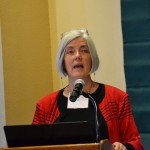 Frances Spivey-Weber, Vice Chair
Frances Spivey-Weber, Vice Chair
Like a drumbeat, Spivey-Weber repeated “We’ve got to work together” in different ways throughout her remarks. “The drought is a huge challenge,” she said. “The most important thing is getting to know people before a crisis occurs. You have to know who to contact in other agencies.”
She said the State Water Board had not had an alliance with the California Office of Emergency Services until recently. By connecting with the agency, “we will be better prepared to handle whatever comes,” she said.
Spivey-Weber commended the Integrated Regional Water Management program. The program was created by SB 1672 in 2002 “to encourage local agencies to work cooperatively to manage local and imported water supplies to improve water quality, quantity and reliability.” Three successive bonds were approved by voters that fund grants for local collaborative plans under the program. She said this approach “offers the shape of the future.”
She talked about the possibility of an El Niño weather pattern next year. An El Niño typically brings large amounts of precipitation in the form of a series of large storms called atmospheric rivers by climate scientists and commonly referred to as a Pineapple Express. She said the State Water Board’s Executive Director, Tom Howard, believes, “We have to manage for what we know. The forecast for an El Niño is not certain yet,” she said. “Tom plays it conservatively. That’s how we’re operating at the State Water Board.”
The curtailment decision, the amount of reduction in water deliveries to State Water Project contractors, will have some flexibility. “The decision can change,” she said, adding, “It will not affect water transfers.”
Spivey-Weber confirmed “pre-1914 water rights are not sacrosanct.” Riparians thought they would never be touched, she said. They are not first in line. However, she recommended that holders of junior water rights prepare for a dry summer.
Spivey-Weber repeated, “This is a family.” She said, “We’re in foreign territory. Conditions are different today than they were in the past. We all have to work together.” ” She invited anyone with concerns to “call me or any member of the board or staff.”
United States Bureau of Reclamation
 Michelle Denning, Mid-Pacific Regional Planning Officer
Michelle Denning, Mid-Pacific Regional Planning Officer
As Mid-Pacific Regional Planning Officer, Denning is responsible for conducting planning studies in most of California, part of southern Oregon, and most of western Nevada. Currently, that includes plans to enlarge Shasta, San Luis and Los Vaqueros dams. In addition, she oversees the Title XVI Recycled Water Program, the Water SMART Basin Studies Program, and water operations and water quality models. She directed her presentation to the difficulties of managing water resources through drought and climate change.
Denning said that in California, the pattern of precipitation has come at the wrong time and the wrong place for the needs of miners, farmers and growing populations. To deal with those problems, Californians constructed systems of storage reservoirs and conveyance canals, pipes and pumps to deliver water to where it was needed. These systems contributed to making California wealthier. Do we need to continue to do more of the same? she asked.
Along the way, environmental values such as protection of fish and other marine animals and plants became included in water management. Additional agricultural considerations now encompass ensuring safe food supplies, increased use of organic pesticides and the planting of permanent crops.
With increased and diverse demands, a multi-year drought and uncertain future climate conditions, the widespread practice of conservation measures–reduce, reuse and recycle–will grow more important.
Denning said current efforts to redesign water management started in the 1990s when CALFED, an affiliation of federal and state agencies involved in water management, reviewed the status of water supply reliability, surface water, conveyance, ecosystem restoration, water use efficiency, watersheds, water quality, levees and science. Around 20 years later, Reclamation is doing feasibility studies on surface storage projects authorized by the 2000 CALFED Bay Delta Programmatic Record of Decision. She mentioned that El Dorado County Water Agency Resource Engineer Tracey Eden-Bishop is a local point person for the Mountain Counties Water Resources Association (MCWRA) and its members for the feasibility studies.
Denning reported on the status of the studies:
1. The Draft EIS and Feasibility Report for the Shasta Enlargement was completed in June 2013. The final is scheduled for completion in December. It will cost an estimated $1 billion to construct.
2. The Draft EIS and Feasibility Report for the Upper San Joaquin River Basin Storage project is due in summer 2014. It contains an in-depth examination of the potential construction of a new dam and reservoir on the upper San Joaquin River between Friant and Kerckoff dams. The Final Report is due in summer 2015. The estimated price tag is $2.5 billion.
3. Phase I of the Los Vaqueros Enlargement project is complete. The dam height was raised and storage increased to 160,000 acre-feet. As part of Phase II, a study is being done to evaluate the feasibility of expanding the reservoir to 500,000 acre-feet.
4. The North of Delta Off-Stream Storage is a 100-year investment. The State Department of Water Resources is the lead agency. The plan envisions a 1.8 million acre feet reservoir. It will be designed for durability under a wide range of conditions.
5. On Dec. 3, 2013, Reclamation released a Draft Appraisal Report describing the methods and costs of increasing the storage capacity of San Luis Reservoir. It also addresses seismic risks under B.F. Sisk Dam. Reclamation estimates that it would cost $360 million to raise the dam by 20 feet and expand the reservoir by 130,000 acre-feet. The report recommends that Reclamation explore opportunities for enlarging the dam with its partners, the State Department of Water Resources, Santa Clara Valley Water District, and the San Luis & Delta-Mendota Water Authority. The comment period ended Jan 17.
Reclamation will be studying the impacts of climate change on its systems’ capabilities, said Denning. What new facilities, new operations and new technology will be required by changes in temperature, precipitation, energy and water demands, economies, ecosystems and plant communities? she posed. “That’s the challenge,” Denning said.
United States Bureau of Reclamation
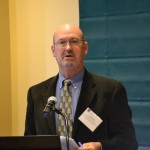 Arlan Nickel, Senior Project Manager, Mid-Pacific Region Basin Study Coordinator
Arlan Nickel, Senior Project Manager, Mid-Pacific Region Basin Study Coordinator
Nickel is responsible for initiating the current four basin studies in the mid-Pacific Region. He is also project manager for the three basin studies that cover most of California: Truckee and the combined Sacramento and San Joaquin basins, including the Tulare basin.
Basin studies
Basin studies are authorized by the SECURE Water Act (Science and Engineering to Comprehensively Understand and Responsibly Enhance Water Act).The Act passed Congress in 2009. In 2010, then Secretary of the Interior Ken Salazar established the WaterSMART (Sustain and Manage America’s Resources for Tomorrow) program to implement the legislation. Reclamation was directed to conduct “comprehensive water studies that define options for meeting future water demands in river basins in the western United States where imbalances in water supply and demand exist or are projected.” The Act requires Reclamation to work with local interests.
WaterSMART special studies follow the comprehensive studies. The California Landscape Conservation Cooperative is one of them. In 2013 a management-science partnership was created to develop landscape-level strategies.
Nickel said the key elements in the basin studies are:
1. Analyzing existing and future basin-wide water supplies and demands.
2. Identifying potential climate impacts to supplies and demands.
3. Identifying adaptive strategies in response to climate impacts.
In the Sacramento-San Joaquin basin study, projections show declines in overall precipitation in the San Joaquin and Tulare basins and uncertainty with respect to the Sacramento basin. The study also projects changes in storm tracks and characteristics.
Specifically, projected precipitation changes indicate a reduction of April 1 snow water average for the 2020s of 53.4 percent, for the 2050s of 75.9 percent, and for the 2070s of 88.6 percent, measured at the Sacramento River at Freeport. The mean April-July runoff measured at the same point is projected at 11.1 percent less in the 2020s, 23 percent less in the 2050s, and 36.1 percent less in the 2070s.
In general, Nickel said the projections for California’s Sacramento-San Joaquin basins indicate a 2-3 degree rise in average annual temperature, a smaller snowpack, longer droughts, and changes in the paths of atmospheric rivers. We need to build in resilience to manage for flood flows and provide carryover for long drought periods, he said.
The announcement for adaptation strategies and options will start April 1 and continue through mid-May. More information is available at http://ww.usbr.gov/mp/SSJBasinStudy.
High elevation storage
Nickel said there have been several studies on adaptation options; for example, groundwater recovery targets, salinity, urban and agricultural use efficiency, recycled municipal water, and desalination. High elevation storage has not been examined.
In keeping with the theme of the program, Nickel focused on high elevation storage as an adaption strategy. He referred to Gerle Creek, Ice House and Hell Home reservoirs, in the Eldorado National Forest, and Bowman Lake, in the Tahoe National Forest, Nevada County, as typical candidates.
Nickel said there are differences between high elevation storage and the other options. High elevation storage is largely unaffected by Delta operations and water quality needs. It is not involved in the Fish and Wildlife and National Marine Fisheries Service Biological Opinion concerns about fish passage. It is the first area that receives annual snowmelt. The watersheds are smaller and relatively isolated. And it has excellent hydropower potential.
Benefits are both regional and downstream. It augments regional water supplies and strengthens local water supply reliability. It provides local revenue from large or small hydropower projects. It buffers high inflow rates to downstream reservoirs, reduces peak flow events on upper tributaries, and reduces downstream levee failure risks. It improves the ability meet downstream riparian and aquatic minimum flow standards. It enhances late summer and fall coldwater management in downstream reservoirs. It sustains water-related recreational activities and related tourism. It integrates water supply and flood control. Nickel said this is a new era of water storage investigations. Nickel invited any partner agency to provide locations of proposed or potential high elevation reservoirs.
Funding is available for projects that meet certain criteria and are ready to go. Criteria include increasing potential yield, technical feasibility and reliability, cost, permitting requirements, energy source and need, long-term viability, and operational flexibility.
Following Nickel’s presentation, Foresthill Public Utility District General Manager Hank White said that his district has a project at Sugar Pine Reservoir that should fit the requirements. Sugar Pine, located in the Tahoe National Forest, is Foresthill’s sole storage reservoir.
Barbara Balen, former Tuolumne Public Utility District director and former Mountain Counties Water Resources Association director, expressed her concerns that high elevation storage might negatively impact archeological sites, river recreation and biodiversity.
To contact Arlan Nickel, email anickel@usbr.gov.
State of California, Governor’s Drought Task Force
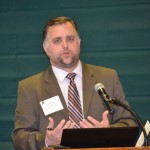 Eric Lamoureux, Regional Administrator, Governor’s Office of Emergency Services Inland Region
Eric Lamoureux, Regional Administrator, Governor’s Office of Emergency Services Inland Region
Lamoureux administers the emergency preparedness, response and recovery program in the 31-county Inland Region, which extends from the Oregon border to Kern County.
When Gov. Brown declared a state of emergency on Jan. 17 due to the record dry conditions in California, he convened an interagency Drought Task Force. The five members are Office of Emergency Services Director Mark Ghilarducci, Department of Food and Agriculture Secretary Karen Ross, Resources Secretary John Laird, State Water Resources Control Board Chair Felicia Marcus, and Martha Guzman-Aceves, Deputy Legislative Secretary, Office of the Governor. All state agencies with a role in supporting drought mitigation and relief are organized under a unified command system.
As of March 4, the U.S. Drought Monitor placed 66 percent of California in D3/D4 conditions.
The U.S. Drought Monitor was established in 2000. The categories are: abnormally dry, moderate drought, severe drought, extreme drought, and exceptional drought. D3 is extreme drought. D4 is exceptional drought. This year is the first time D4 has been used.
Following the Governor’s proclamation, 16 counties and five tribes issued local drought emergency proclamations.
Lamoureux said that the water levels in reservoirs, rivers and groundwater around the state are low. Farmers who depend heavily on water from the State Water Project and Central Valley Water Project face minimal and uncertain supplies. Water districts with multiple water sources and ample storage are better prepared to weather a third dry winter.
Gov. Brown signed emergency legislation to fund shovel-ready projects and emergency assistance. The largest amount, $549 million, is targeted for infrastructure grants to increase storm water capture, recycled water, groundwater management and water conservation. Other projects are emergency food assistance, housing-related assistance, alternative water supplies for communities with drinking water shortages, and removing groundwater contamination. The state’s cap-and-trade program will be tapped for $40 million for water agencies to improve water and energy efficiency, helping farmers upgrade irrigation and water pumping, and enabling retrofits in commercial and residential buildings that improve water and energy efficiency.
The Drought Task Force is assessing direct or indirect impacts to electricity supply, fire threats, security threats, and other threats to life and property, as it continues to develop response plans.
Association of California Water Agencies
 Jennifer Persike, Deputy Executive Director of External Affairs and Operations
Jennifer Persike, Deputy Executive Director of External Affairs and Operations
Persike said that ACWA members have faced a number of serious droughts in the organization’s 104-year history. “Each drought is unique,” she said. Each affects different areas and has different impacts. The common theme is that areas most impacted are those that depend on a single watershed or source of supply.
In an informal survey of members in early 2014, 77 percent reported they have drought contingency plans in place, and 82 percent have conservation campaigns aimed at customers.
Member representatives from around the state formed a Drought Action Group in January. The group will present needed actions to alleviate the impacts of this and future droughts to the Brown administration.
Persike talked about communications among statewide response teams and messaging to the public. Briefings and Webcasts are employed, with drought updates and weekly talking points on conditions. An interactive map, updated daily, is available on www.acwa.org.
An extensive media campaign has been initiated. An information clearinghouse provides speakers from the League of California Cities, California Business Roundtable, California Water Commission, Sacramento Area Council of Governments, Sustainable Ag Expo and UC Davis Resources Seminar. Key talking points are: 2014 is unprecedented drought year; the Governor’s drought declaration sends a powerful signal; the impacts vary by region; we are one state; all must do our part; future investments are needed.
“Save Our Water” is a public education program created in 2009 in response to drought. It is a partnership between ACWA and the Department of Water Resources managed by ACWA. It complements local programs and focuses on the consumer. Underlying research indicates that the public is willing to conserve, but desires specific suggestions.
The “Save Our Water” campaign uses radio ads, Facebook, Twitter, videos with the message “Californians Don’t Waste,” and materials in English and Spanish.
The next stage is to incorporate polling and increase paid advertising via radio, social media, billboards, including digital, and theater ads.
Persike said, “The 2014 drought will cut into the fabric of our economy. It will require active management by local water agencies, and a conservation ethic among our citizens to get us through 2014.” It will demand comprehensive solutions like ACWA’s Statewide Water Action Plan and the Brown administration’s California Water Action Plan.
For more information, visit www.saveourh2o.org.
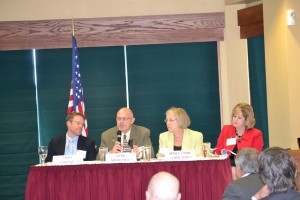 Member drought panel discussion
Member drought panel discussion
All three member representatives reported prospective losses to their agencies due to lower water sales as a result of the drought.
Tony Frienzi, Deputy Director of Technical Services, Placer County Water Agency
Frienzi said Placer County Water Agency is anticipating $2.7-$3.8 million drop in current demand reductions. Added costs, such as pumping, are expected to be in the $4 million range. The net is a $7 million impact on our budget,” he said. This will be offset by reserves and reprioritizations.
Placer County Water Agency obtains water for its Western Water System by a contract with PG&E. PG&E has informed the water agency not to expect delivery of enough water for even minimum normal requirements. The water agency is anticipating a 50 percent or greater cut from PG&E. On Feb. 6, the board declared a water shortage emergency.
Frienzi said Placer County Water Agency usually has some flexibility with interties, groundwater and small surface storage. It has agreements to purchase water from the San Juan Water District and the City of Roseville. Those purveyors take their water from Folsom Lake, and will have little or no water to spare. Placer County Water Agency is advocating for changes in the operations of Folsom Dam.
Placer County Water Agency has a reputation for grassroots communicating, he said. The agency is using the Web, Twitter and public forums to inform its customers. To illustrate the severity of the situation, it is showing photos of Folsom Dam, “the poster child for drought in northern California.”
Gene Mancebo, General Manager, Amador Water Agency
Amador Water Agency serves five cities in Amador County. The Mokelumne River supplies 95 percent of the surface water. The agency holds pre-1914 water rights. It leases storage from PG&E. Mancebo reported the agency has experienced some conflicts regarding management for hydroelectric service and management for water supply.
Lake Comanche Village, in western Amador County, receives the remaining five percent of the agency’s water supply from groundwater wells.
Amador Water Agency is vulnerable to effects on the budget from the drought. Mancebo said He expects an 8-20 percent budget reduction, but so far the board has not instituted a drought surcharge.
For the future, the agency is taking action to address the effects of the drought: an interregional conjunctive use project, recycling and conservation programs, and a new piping system. “We think we can get by 2014,” he said. “Our concern is 2015.”
Mary Lynn Carlton, Communications and Community Relations Director, El Dorado Irrigation District (EID)
Carlton said EID has 100,000 customers in El Dorado County. It has operational flexibility because it purchased Project 184 from PG&E in 1999 and purchased Sly Park Dam and Jenkinson Lake Reservoir from the U.S. Bureau of Reclamation in 2003. Project 184 has four alpine lakes, a complex conveyance system, and other facilities. Jenkinson Lake has connected facilities.
Jenkinson Lake has a capacity of 41,000 acre-feet. On Feb. 28, the lake held 29,920 acre-feet, 10 percent below average for this time of year. Carlton said EID was able to “top off” Jenkinson Lake by transferring water through a pipe from the South Fork of the American River.
EID also has rights to water from Folsom Lake, but the allocation this year is estimated at 5,900 acre feet, about 50 percent of its full entitlement.
In 2008, EID adopted a Drought Preparedness Plan and updated it in 2012 with a Drought Action Plan. On Feb. 4, the EID board issued a Stage 2 water warning and emergency declaration, calling for a voluntary 30 percent reduction in water usage by its customers. The board deferred action on a drought surcharge.
The district is now preparing for a multi-year drought. A key feature will be to maintain the level of Jenkinson Lake at around 25,000 acre-feet into October.
Carlton said the drought has affected the ability of the district to sell hydropower. EID’s average annual revenue from hydropower is between $8 and $12 million. Now it is around $3 to $4 million.
She said the district was able to offset some of the revenue losses by refinancing its debt with a lower interest rate, resulting in a savings of $17 million.
To inform its customers and the public, EID has a dedicated Drought page on its Website. Carlton said the district uses ACWA’s “Save Our Water” campaign. She said EID is accelerating its level of communications with the external world through media outreach and speakers at community groups and schools.
Member support
The program was hosted by Nevada Irrigation District and Calaveras County Water District. ATKINS and the Sierra Nevada Conservancy underwrote the program.
Atkins is an international firm providing design, engineering, planning and project management consultancy services to public and private clients worldwide.
The Sierra Nevada Conservancy is a state agency that supports the Sierra Nevada environmental, economic and social well-being by providing funding for local projects, offering technical assistance and supporting collaborative projects. Executive Officer Jim Branham said, “As usual, Mountain Counties did a great job of bringing together key decision makers for an interesting and informative program. The SNC is proud to have sponsored the event, and we appreciate the positive working relationship we have with MCWRA.”
View all the pictures from the program
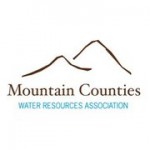 This is a reminder to RSVP for this important workshop
This is a reminder to RSVP for this important workshop











